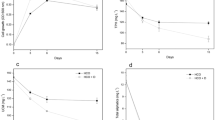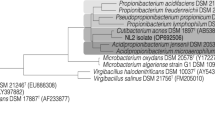Abstract
The feasibility of using an indigenous microbial consortium for the removal of crude oil from an oil-spilled coastal area was explored with the ultimate aim of applying for bioremediation. Initially, we obtained the microbial consortium TK-2 that catalyzed the dispersion as well as the degradation of crude oil in supplemented sea water. GC and GC-MS were used to evaluate the removal patterns of crude oil during the incubation. The effective removal of crude oil by TK-2 occurred, and above 95 % of all aliphatic and aromatic compounds detected in this work was removed within 30 days of incubation. Two predominant crude oil-grown isolates derived from TK-2 revealed Gram-negative, rod-shaped cells. Both BIOLOG system and 16S rRNA sequencing were conducted to identify the strains, which were assigned to Arthrobacter sp. HK-2 and Pseudoalteromonas sp. HK-3, and registered in GenBank as [FJ477042] and [FJ477041].




Similar content being viewed by others
References
Atlas R, Bragg J (2009) Bioremediation of marine oil spills: when and when not-the Exxon Valdez experience. Microbial Biotechnol 2:213–221
Batista SB, Mounteer A, Amorim FR, Totola MR (2006) Isolation and characterization of biosurfactant/bioemulsifier-producing bacteria from petroleum contaminated sites. Bioresour Technol 97:868–875
Cho SH, Oh KH (2010) Characterization of the biosurfactant-producing bacterium, Pseudoalteromonas sp. HK-3 isolated from the crude-oil contaminated areas. Kor J Microbiol 46:346–351
Cho SH, Ma CW, Oh KH (2011) Optimized production of biosurfactant by the indigenous bacterium, Pseudoalteromonas sp. HK-3 originating from oil-spilled areas. KSBB J. 26:57–61
Cunha CD, Rosado AS, Sebastian GV, Seldin L, von der Weid I (2006) Oil biodegradation by Bacillus strains isolated from the rock of an oil reservoir located in a deep-water production basin in Brazil. Appl Microbiol Biotechnol 73:949–959
Deppe U, Richnow HH, Michaelis W, Antranikian G (2005) Degradation of crude oil by an arctic microbial consortium. Extremophiles 9:461–470
Hamamura N, Yeager CM, Arp DJ (2001) Two distinct monooxygeneases for alkane oxidation in Nocardioides sp. strain CF8. Appl Environ Microbiol 67:4992–4998
Harayama S, Kishira H, Kasai Y, Shutsubo K (1999) Petroleum biodegradation in marine environments. J Mol Microbiol Biotechnol 1:63–70
Hazen TC, Dubinsky EA, DeSantis TZ, Anderson GL, Piceno YM, Singh N et al (2010) Deep-sea oil plume enriches indigenous oil-degrading bacteria. Science 300:204–2008
International Tanker Owners Pollution Federation Ltd (ITOPF) (2008) The environmental impact of the Hebei Spirit oil spill, Taean, South Korea. http://www.itopf.com/news-and-events/documents/HEBEISPIRIT-Environmentalimpact.pdf (07.12.07)
Kato T, Haruki M, Imanaka T, Morikawa M, Kanaya S (2001) Isolation and characterization of psychrotrophic bacteria from oil-reservoir water and oil sands. Appl Microbiol Biotechnol 55:794–800
Lai B, Khanna S (1996) Degradation of crude oil by Acinetobacter calcoaceticus and Alcaligenes odorans. J Appl Bacteriol 81:355–362
Leacock E (2005) The Exxon Valdez oil spill. Facts on file Inc, New York, pp 34–46
Lin X, Yang B, Shen J, Du N (2009) Biodegradation of crude oil by an arctic psychrotrophic bacterium Pseudoalteromonas sp. P29. Curr Microbiol 59:341–345
Mittal A, Singh P (2006) Isolation of hydrocarbon degrading bacteria from soils contaminated with crude oil spills. Ind J Exp Biol 47:760–765
Rahman KSM, Thahira-Rahman J, Lakshmanaperumalsamy P, Banat IM (2002) Towards efficient crude oil degradation by a mixed bacterial consortium. Bioresour Technol 85:257–261
Sathishkumar M, Binupriya AR, Baik SH, Yun SE (2008) Biodegradation of crude oil by individual bacterial strains and a mixed bacterial consortium isolated from hydrocarbon contaminated areas. Clean 36(1):92–96
Swannell RPJ, Lee K, McDonagh M (1996) Field evaluations of marine oil spill bioremediation. Microbiol Rev 60:342–365
Tang X, He LY, Tao XQ, Dang Z, Guo CL, Lu GN, Yi XY (2010) Construction of an artificial microalgal-bacterial consortium that efficiently degrades crude oil. J Hazard Mater 181:1158–1162
Toledo FL, Calvo C, Rodelas B, Gonzalez-Lopez J (2006) Selection and identification of bacteria isolated from waste crude oil with polycyclic aromatic hydrocarbons removal capacities. Syst Appl Microbiol 29:244–252
Van Hamme JD, Singh A, Ward OP (2003) Recent advances in petroleum microbiology. Microbiol Molec Biol Rev 67:503–549
Acknowledgment
This work was supported in part by the Soonchunhyang University Research Fund.
Author information
Authors and Affiliations
Corresponding author
Rights and permissions
About this article
Cite this article
Cho, SH., Oh, KH. Removal of Crude Oil by Microbial Consortium Isolated from Oil-Spilled Area in the Korean Western Coast. Bull Environ Contam Toxicol 89, 680–685 (2012). https://doi.org/10.1007/s00128-012-0723-7
Received:
Accepted:
Published:
Issue Date:
DOI: https://doi.org/10.1007/s00128-012-0723-7




